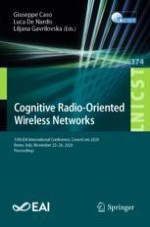2021 | Book
Cognitive Radio-Oriented Wireless Networks
15th EAI International Conference, CrownCom 2020, Rome, Italy, November 25-26, 2020, Proceedings
Editors: Giuseppe Caso, Luca De Nardis, Prof. Dr. Liljana Gavrilovska
Publisher: Springer International Publishing
Book Series : Lecture Notes of the Institute for Computer Sciences, Social Informatics and Telecommunications Engineering
